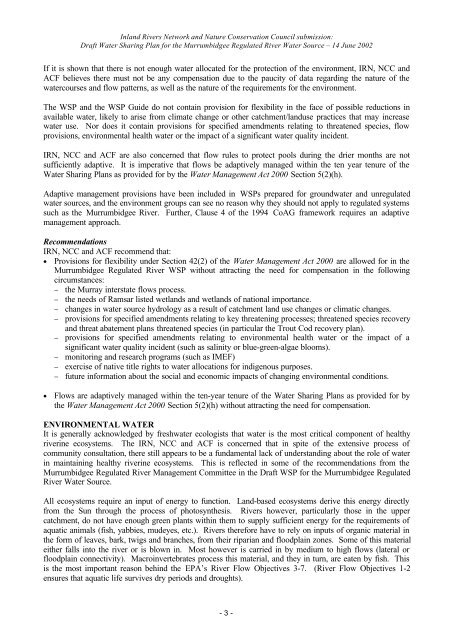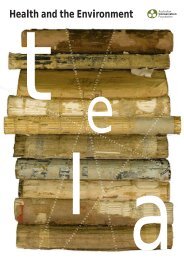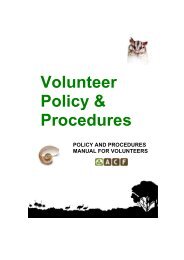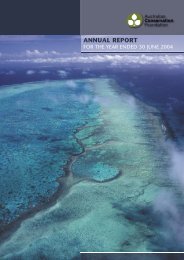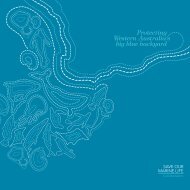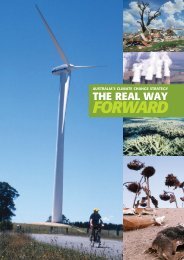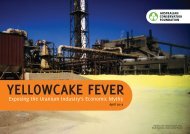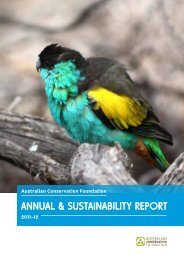Submission on Draft Water Sharing Plan for the Murrumbidgee River
Submission on Draft Water Sharing Plan for the Murrumbidgee River
Submission on Draft Water Sharing Plan for the Murrumbidgee River
You also want an ePaper? Increase the reach of your titles
YUMPU automatically turns print PDFs into web optimized ePapers that Google loves.
Inland <strong>River</strong>s Network and Nature C<strong>on</strong>servati<strong>on</strong> Council submissi<strong>on</strong>:<br />
<strong>Draft</strong> <strong>Water</strong> <strong>Sharing</strong> <strong>Plan</strong> <strong>for</strong> <strong>the</strong> <strong>Murrumbidgee</strong> Regulated <strong>River</strong> <strong>Water</strong> Source – 14 June 2002<br />
If it is shown that <strong>the</strong>re is not enough water allocated <strong>for</strong> <strong>the</strong> protecti<strong>on</strong> of <strong>the</strong> envir<strong>on</strong>ment, IRN, NCC and<br />
ACF believes <strong>the</strong>re must not be any compensati<strong>on</strong> due to <strong>the</strong> paucity of data regarding <strong>the</strong> nature of <strong>the</strong><br />
watercourses and flow patterns, as well as <strong>the</strong> nature of <strong>the</strong> requirements <strong>for</strong> <strong>the</strong> envir<strong>on</strong>ment.<br />
The WSP and <strong>the</strong> WSP Guide do not c<strong>on</strong>tain provisi<strong>on</strong> <strong>for</strong> flexibility in <strong>the</strong> face of possible reducti<strong>on</strong>s in<br />
available water, likely to arise from climate change or o<strong>the</strong>r catchment/landuse practices that may increase<br />
water use. Nor does it c<strong>on</strong>tain provisi<strong>on</strong>s <strong>for</strong> specified amendments relating to threatened species, flow<br />
provisi<strong>on</strong>s, envir<strong>on</strong>mental health water or <strong>the</strong> impact of a significant water quality incident.<br />
IRN, NCC and ACF are also c<strong>on</strong>cerned that flow rules to protect pools during <strong>the</strong> drier m<strong>on</strong>ths are not<br />
sufficiently adaptive. It is imperative that flows be adaptively managed within <strong>the</strong> ten year tenure of <strong>the</strong><br />
<strong>Water</strong> <strong>Sharing</strong> <strong>Plan</strong>s as provided <strong>for</strong> by <strong>the</strong> <strong>Water</strong> Management Act 2000 Secti<strong>on</strong> 5(2)(h).<br />
Adaptive management provisi<strong>on</strong>s have been included in WSPs prepared <strong>for</strong> groundwater and unregulated<br />
water sources, and <strong>the</strong> envir<strong>on</strong>ment groups can see no reas<strong>on</strong> why <strong>the</strong>y should not apply to regulated systems<br />
such as <strong>the</strong> <strong>Murrumbidgee</strong> <strong>River</strong>. Fur<strong>the</strong>r, Clause 4 of <strong>the</strong> 1994 CoAG framework requires an adaptive<br />
management approach.<br />
Recommendati<strong>on</strong>s<br />
IRN, NCC and ACF recommend that:<br />
• Provisi<strong>on</strong>s <strong>for</strong> flexibility under Secti<strong>on</strong> 42(2) of <strong>the</strong> <strong>Water</strong> Management Act 2000 are allowed <strong>for</strong> in <strong>the</strong><br />
<strong>Murrumbidgee</strong> Regulated <strong>River</strong> WSP without attracting <strong>the</strong> need <strong>for</strong> compensati<strong>on</strong> in <strong>the</strong> following<br />
circumstances:<br />
− <strong>the</strong> Murray interstate flows process.<br />
− <strong>the</strong> needs of Ramsar listed wetlands and wetlands of nati<strong>on</strong>al importance.<br />
− changes in water source hydrology as a result of catchment land use changes or climatic changes.<br />
− provisi<strong>on</strong>s <strong>for</strong> specified amendments relating to key threatening processes; threatened species recovery<br />
and threat abatement plans threatened species (in particular <strong>the</strong> Trout Cod recovery plan).<br />
− provisi<strong>on</strong>s <strong>for</strong> specified amendments relating to envir<strong>on</strong>mental health water or <strong>the</strong> impact of a<br />
significant water quality incident (such as salinity or blue-green-algae blooms).<br />
− m<strong>on</strong>itoring and research programs (such as IMEF)<br />
− exercise of native title rights to water allocati<strong>on</strong>s <strong>for</strong> indigenous purposes.<br />
− future in<strong>for</strong>mati<strong>on</strong> about <strong>the</strong> social and ec<strong>on</strong>omic impacts of changing envir<strong>on</strong>mental c<strong>on</strong>diti<strong>on</strong>s.<br />
• Flows are adaptively managed within <strong>the</strong> ten-year tenure of <strong>the</strong> <strong>Water</strong> <strong>Sharing</strong> <strong>Plan</strong>s as provided <strong>for</strong> by<br />
<strong>the</strong> <strong>Water</strong> Management Act 2000 Secti<strong>on</strong> 5(2)(h) without attracting <strong>the</strong> need <strong>for</strong> compensati<strong>on</strong>.<br />
ENVIRONMENTAL WATER<br />
It is generally acknowledged by freshwater ecologists that water is <strong>the</strong> most critical comp<strong>on</strong>ent of healthy<br />
riverine ecosystems. The IRN, NCC and ACF is c<strong>on</strong>cerned that in spite of <strong>the</strong> extensive process of<br />
community c<strong>on</strong>sultati<strong>on</strong>, <strong>the</strong>re still appears to be a fundamental lack of understanding about <strong>the</strong> role of water<br />
in maintaining healthy riverine ecosystems. This is reflected in some of <strong>the</strong> recommendati<strong>on</strong>s from <strong>the</strong><br />
<strong>Murrumbidgee</strong> Regulated <strong>River</strong> Management Committee in <strong>the</strong> <strong>Draft</strong> WSP <strong>for</strong> <strong>the</strong> <strong>Murrumbidgee</strong> Regulated<br />
<strong>River</strong> <strong>Water</strong> Source.<br />
All ecosystems require an input of energy to functi<strong>on</strong>. Land-based ecosystems derive this energy directly<br />
from <strong>the</strong> Sun through <strong>the</strong> process of photosyn<strong>the</strong>sis. <strong>River</strong>s however, particularly those in <strong>the</strong> upper<br />
catchment, do not have enough green plants within <strong>the</strong>m to supply sufficient energy <strong>for</strong> <strong>the</strong> requirements of<br />
aquatic animals (fish, yabbies, mudeyes, etc.). <strong>River</strong>s <strong>the</strong>re<strong>for</strong>e have to rely <strong>on</strong> inputs of organic material in<br />
<strong>the</strong> <strong>for</strong>m of leaves, bark, twigs and branches, from <strong>the</strong>ir riparian and floodplain z<strong>on</strong>es. Some of this material<br />
ei<strong>the</strong>r falls into <strong>the</strong> river or is blown in. Most however is carried in by medium to high flows (lateral or<br />
floodplain c<strong>on</strong>nectivity). Macroinvertebrates process this material, and <strong>the</strong>y in turn, are eaten by fish. This<br />
is <strong>the</strong> most important reas<strong>on</strong> behind <strong>the</strong> EPA’s <strong>River</strong> Flow Objectives 3-7. (<strong>River</strong> Flow Objectives 1-2<br />
ensures that aquatic life survives dry periods and droughts).<br />
- 3 -


